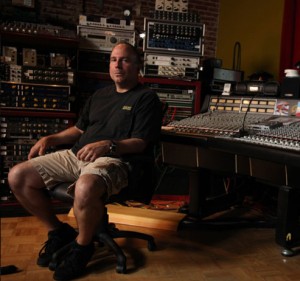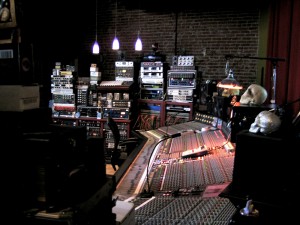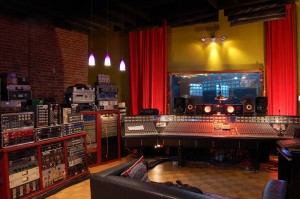In The Studio With…Joe Barresi — The Mixing Mindset for QOTSA, Chevelle & Bad Religion
“Every penny that I’ve ever made went back into audio gear.”
Joe Barresi‘s passion for his work is palpable, and not just in the rows of guitars, amps or stacks of gear you see around his studio in Pasadena. It’s in the way he describes his approach and his craft that leaves no question as to why the likes of Soundgarden, Tool, Queens of the Stone Age, Judas Priest, Bad Religion and more have asked Barresi to lend his ears and mind to their music.
To hazard a guess, I’d say his studio rarely sits dormant and that’s how he likes it.
When I visited, Barresi was getting ready to dig into a mix for Slipknot drummer Joey Jordison‘s solo project. He’d also recently mixed the song “Fairweather Friends” for the new Queens of the Stone Age album, …Like Clockwork, which Time Magazine called “dark, personal and heroic”, and which just earned the band its first #1 on the Billboard 200. Barresi has been involved with QOTSA since the beginning – co-producing their 1998 debut – and even further back, engineering for Josh Homme’s previous band Kyuss.
On deck to mix next is Bad Religion, whose latest album Barresi also tracked. In October, if all goes as planned, he’ll start on Chevelle‘s new album, and in the interim, some tracking with his pal Alain Johannes and a rhythm section from a previous client whose name he can’t disclose as of yet.
Hearing that his studio is a hub for both tracking and mixing, I was very curious as to how he approaches a mix job as opposed to being there from the beginning, like with Chevelle’s Hats off to the Bull, which he produced, engineered and mixed.
He smiles, pausing for a moment to bend down and pet his black lab, Bullet.
“Well, when I track it, I already know where the bodies are buried, so it’s very easy to mix because I’ve made it sound the way I want it to sound in the end,” he says. “When I’m mixing other people’s [recordings], it may take me a day to sort through tracks and figure out what was what and what kinda works and what doesn’t, often blending multiple mics together because most people don’t commit to anything anymore.
“The ease of track availability in the digital world allows one to prolong decision making until the very end. People would rather throw up another open track and record everything separately or do an insane amount of takes as opposed to getting the sound or performance they really want or should be trying to capture on a single track.
“I mean I combine everything – I’m used to the tape machine mentality – so I’ve got 23 tracks, 24 with time code.
“Even when I did Tool, I had it down on 46 tracks, because I knew it was gonna end up on two multi-tracks for archiving.
“Some of these current ‘modern’ sessions have over 100 tracks and I have to combine everything even just to listen to them, so it takes a while. And many times these ‘modern’ productions enlist outside musicians working out of their own home studios so they just pile their own thing on there, and no one really sorts through it because there’s no producer, so the mixer becomes more of a producer as well.
“Nothing against home studios. It’s great to have a low dough, low pressure situation, with the ability to pass along our sessions to whomever and they can add to the music without ever leaving their bedroom.
“But, at some point, there has to be a person with a vision driving the plane. A well-produced song will mix itself. Mixing 100+ tracks isn’t mixing to me. The creativity you would bring to the table is stifled by all the thought process you have to use to sort through the excess.”
Tape Tricks
As someone who thinks in terms of tape and uses Pro Tools primarily as a “playback engine and surgical tool,” Barresi tries not to get sucked in to what he calls “engine-eyes, not engineers,” where your eyes make the decisions your ears should be. While he doesn’t shy away from Auto-Tune or spot editing when necessary, he spends the bulk of his time creating sounds outside the 1s and 0s of Pro Tools.
To assist in his love for tape, Barresi has two Studer 800s bookending the walls of his studio, and not surprisingly, he uses them for more than the usually expected applications.
“The last Bad Religion record we did went all to tape. I even made slave reels. We cut the drums, then dumped kick, snare and a stereo drum mix to a piece of tape and recorded all the guitars and bass on the slave reel, dumped it into Pro Tools, did the vocals in Pro Tools, dumped ’em to tape and back.
“And some stuff I mix, I’ll add tape to [as an effect]. Like I mixed a song on the Queens record where I did some tape flanging by locking Pro Tools with the tape machine, and doing some shit with the time code and a PCM 42 [delay], and delaying the time code across the zero point so that the tape machine would vary against the Pro Tools tracks. It’s a Bill Kennedy trick from ages ago that he taught me about manipulating time code with two locked tape machines.
“I worked a lot with Mike Stone coming up, who did all the early Queen records and he taught me how to flange tape but you need four tape machines to do all that Queen shit and I don’t have four tape machines. I don’t have the desire to come near four tape machines. But locking up a Pro Tools rig and a tape machine and then taking time code off the repro head of the tape machine and delaying it with a delay is unbelievable.”
It’s All About Experimentation
While he spends a few two-day blocks a year teaching intensive recording classes, Barresi is himself a constant and avid student of audio. From learning about software drum sampling by working with FXpansion BFD on the “Evil Joe” drum collection to building his own effects pedals, he is eager and willing to push boundaries, and find new ways of advancing his craft.
It’s something his workshops focus on quite a bit: “getting people to use their ears and preserving the art of recording.”
“I mean we’ll do a drum workshop and before we even move a mic, we’re moving drums around in the live room – which no one even thinks about anymore. It’s like, oh I’ll just throw a mic up, record it, throw a sample on there, sound-replace it, it’s done. And meanwhile, this drum set sounds so different in all the corners of the room – so we’re trying to get people to use their ears.”
Though he’s been collecting gear since age 7, and has some of the most amazing pieces sprinkled throughout his studio, Joe maintains that it’s not a matter of how much gear you have or what your setup looks like. It’s the time you take to create and to explore, and your own drive that trumps all the gear – even the BA-6A he got for a paltry $500 .
“If someone says they don’t have time to do it, they don’t really want to do it,” he assures. “If you have that desire, that passion to get ahead – I mean, just because you only have a home studio doesn’t mean you shouldn’t be reading Sound on Sound, Mix, Electronic Musician Magazine and going to the Library or the Op-Amp Technical bookstore – I went to that place and bought a book on Modern Recording except it was copyright like ’71 and there were all these wild and crazy things in there – like this guy talking about flanging by moving the microphone, and so the next session I thought, ‘I don’t need a flanger to do this’ so I got on the ground and started twirling the microphone around in front of this guy’s guitar cabinet and it was the coolest sound.
“It’s those moments that people remember on records that make shit fun, that make you a part of it, and that’s how your career develops as well.
“It’s shit that could easily be done with a plug-in but it’s way cooler if you don’t – it’s that inspiration, that exploration. It’s that moment and that magic. I can’t tell you how many times I’ve had bands say – oh I’m so glad you didn’t use any reverb on my vocal. Well, I didn’t need reverb – I’ve got a big ass room and some compression – just go out there and sing against the wall and there’s your reverb.
“On the QOTSA record, Lullabies to Paralyze, Josh sang all the lead vocals in the studio bathroom. How much of the room mic you blend in is your reverb. Those are the moments that make your stuff sound different – why people come back to you.
“I mean a couple of weeks ago Chris Cornell called me – ‘Hey, what was that pedal that we plugged into?’ And if I’d just put a plug-in on there, I don’t think he would’ve called me. It’s because we plugged into this weird little thing, and stepped on it, with this glorious sound and distortion – and he was like, ‘I gotta have that.’”
How to Listen in Advance
Whether it’s plugging in a custom pedal or organizing a mix, Barresi makes his mark by approaching each project with the same level of creativity, passion and work ethic. While he feels he has a distinct sound and characteristic to his work, he thoroughly believes in doing his homework and making sure that the artist’s vision is captured. Before starting to work on his current project, he spent the whole day listening to Slipknot records just to find out more about Joey’s drumming style.
“I look back at all the records bands work on. What do I like and hate about it? And also what do you wanna sound like? Why are you coming to me? What can I do for you? Then, honestly, the way I hear things is different from other people so I have different gear, I have different speakers, a different room. I inflate the sound, I try to augment it. I mean if you play a Les Paul, I’m not gonna say, well you have to play a Strat. I want you play a Les Paul but if your Les Paul sucks then we’re gonna augment your Les Paul with stuff that makes you sound better. It’s an education process, even if you don’t know that you’re being educated. I’ve had people say to me ‘thanks for making me a better player‘ at the end of the project.
“I can remember when I was doing a record and I had the opportunity to sort through songs before mixing, and there were things like ‘hey, this song needs a guitar overdub but I don’t wanna come out and go hey, this song needs a guitar overdub. So, I remember tuning a guitar into the ‘Rain Song’ tuning because it was a Zeppelin-y kinda thing and I actually went onto YouTube to try and learn the ‘Rain Song’ before the artist got here and then set the guitar on the corner of the couch in this really crazy tuning and had some music playing in the background when he walked in. We sat around and talked for a minute and then he says ‘hey what’s going on with this guitar?
“‘Oh, it’s in this crazy tuning, you should check it out.’ And before you know it, he picks it up, starts playing and meanwhile the track is going. It’s plugged in and it’s miked up and then it becomes an overdub on a song in a moment of inspiration.
“Sometimes the psychological part of it is just as important as the work, only this place doesn’t look like a workplace – it looks like you’re gonna be hanging out in your bedroom with your friends, listening to music. That’s the way it should be. You come in here and say, ‘hey what’s that weird thing over there?’ I’m gonna start playing that weird thing – and before you know it, there’s a mic in front of it.”
As an artist myself, I can easily see, and feel that. From Bullet lounging on the rug to kitschy décor like Devo Dolls and a Marshall refrigerator, Barresi’s studio feels like your muse lives there, your favorite bands have played there and the two of them teamed up to decorate.
His SSL 4000G+ is adorned with skulls and a bike leans up against Mesa and Naylor cabs. The original sign from the 1930s “Lawnmower and Garden Supplies Store” still hangs above the lounge area.
It’s a distinct and seamless parallel to a man who loves what he does and has fun doing it.
After lunch and once Bullet has had his walk, it’s back to creating, augmenting, playing and mixing.
And for me, I’m off to the Op-Amp Technical Bookstore to see what I can dig up on “Modern” Recording.
Eleanor Goldfield is a Los Angeles-based writer, musician and studio tech. She is lead singer in the hard rock band, Rooftop Revolutionaries, and chief tech at The Village Studios.
Please note: When you buy products through links on this page, we may earn an affiliate commission.










Dan Abrusci
June 18, 2013 at 5:48 pm (12 years ago)Great Article!!!
Tino @ Avatar Studios NYC
June 20, 2013 at 3:19 pm (12 years ago)Great piece on a great engineer, and more importantly a great guy!
Hey Breezy, we miss you over here at Avatar! Drop by some time, will ya!
todd rodger
June 25, 2013 at 6:20 am (12 years ago)I love Joe’s approach to recording…